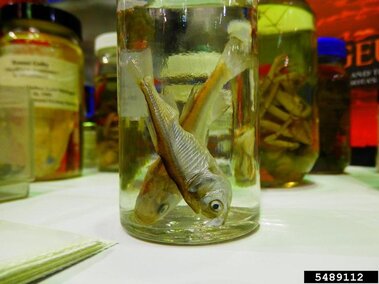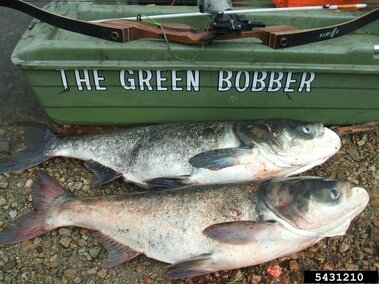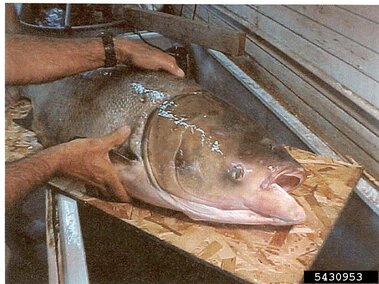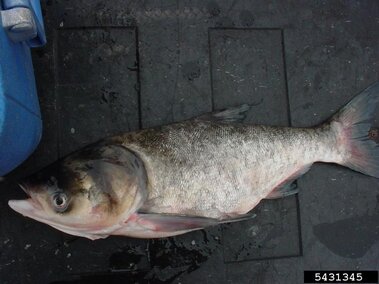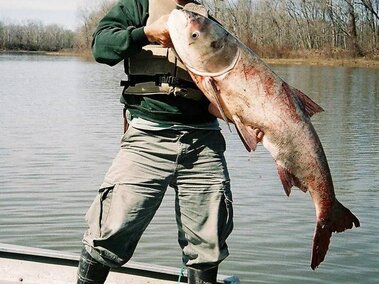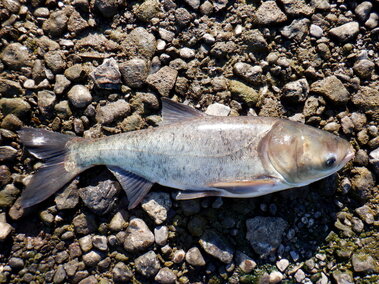General Information
Species Name: Hypophthalmichthys nobilis
Also Known As: invasive carp
Family: Xenocyprididae (Sharpbelly)
Life Span: Usually between 8-10 years, up to 16 years
Life Cycle: Bighead carp spawn in large turbulent rivers after spring rains floods and water temperatures reach 77 Fahrenheit. Males reach sexual maturity as early as two years old and females as early as three years old. The semi-buoyant eggs are fertilized externally and float down river for 40 to 60 hours before hatching and must remain in the current to prevent sinking. Females can produce up to a million eggs per year. They can hybridize, meaning that they cross-breed, with silver carp and produce viable, reproductive offspring.
Origin: Asia
Injurious: Yes. Currently under the Lacey Act, bighead carp are listed as injurious wildlife by the U.S. Fish and Wildlife Service, which prohibits the importation into or transportation between the continental United States, the District of Columbia, Hawaii, the Commonwealth of Puerto Rico or any territory or possession of the United States of live bighead carp, gametes, viable eggs and hybrids.
Category 2: Priority Aquatic Invasive Species
Why Are They Invasive?
Bighead carps are a powerful filter-feeder with a wide food spectrum that grows fast and reproduces quickly, which makes this species a strong competitor. The diet of this species overlaps with that of planktivorous species (fish and invertebrates) and to some extent with that of the young of virtually all native fishes. Bighead carp are thought to deplete plankton stocks for native larval fishes and mussels. They lack a true stomach which requires them to feed almost continuously.
What Do They Look Like?
Bighead carp are a large, deep bodied fish that have a large, scaleless head and a large toothless mouth with a protruding lower jaw. The bighead carp's eyes are far forward and low on the head, projecting downward. The coloration of the body is dark gray, fading to white toward the underside with dark irregular blotches on the sides. They have a belly keel that extends from the vent to the base of the pelvic fins. They can grow up to nearly 5 feet in length and commonly reach 40 pounds with some individuals reaching over 100 pounds. The current world record bighead carp weight was 125 pounds, 5 ounces (56.84 kg) and was caught in Missouri.
Photos
Where Do They Live?
Bighead carp inhabit freshwater river systems, confluent lakes, impoundments and reservoirs. They can tolerate water temperatures of 0.5 °C to 38 °C (32.9 °F to 100.4 °F) . Bighead carp stay in the upper layer of the water column and in waters with abundant natural food and low flow. In the United States, bighead carp are currently spread throughout the Mississippi River, Missouri River and Ohio River systems within or along the border of 23 states. In Nebraska, they have been found on the Platte River as far west as Lexington, the Elkhorn as far as Neligh, the Loup as far as Burwell and the Big Nemaha as far as Tecumseh.
How Do They Spread?
Bighead carp are one of four non-native fish species that belong to a group commonly referred to as invasive carp. They were first imported into the United States in 1973 to improve water quality and increase fish production in aquaculture ponds. By the 1980s, bighead carp had escaped into the Mississippi River drainage due to high water flooding events. They are also thought to be moved by anglers who use juvenile bighead carp as bait and then release them into a waterbody. In Nebraska, it is illegal to move any species from waterbody to another or to possess a live bighead carp.
How Do I Control Them?
Management of invasive fish involving either mechanical removal or application of chemicals to public waters requires a permit. Contact the Contact the Nebraska Game and Parks Commission for more information.
CLEAN your watercraft, trailer, angling gear and other equipment. Remove all aquatic vegetation and animal species from your equipment.
DRAIN your watercraft at the ramp by removing the boat plug and draining all live wells and ballast tanks.
DRY your watercraft, trailer and other equipment for at least 7 days before visiting another waterbody.
DON'T DUMP BAIT. Dispose of bait by emptying bait buckets on dry land, away from waterbodies or in a trash receptacle. Moving a live organism from one waterbody to another is illegal, even if you are planning to use the organism as bait.
DON'T LET IT LOOSE. Do not release or transport exotic or non-native fish species to new ecosystems. It is unlawful to release any aquatic species into a waterbody other than the one from which it was harvested. Doing so can promote the spread of AIS.
What Should I Do If I See Them in Nebraska?
If you see bighead carp in Nebraska, you should report them to the Nebraska Game and Parks Commission's Aquatic Invasive Species (AIS) Program using their AIS Report Form. For guidance on what information to include in your report, check out our reporting tips.
References and More Information
Center for Invasive Species and Ecosystem Health
Illinois Department of Natural Resources
Nebraska Game and Parks Commission
Fowler, E. (2021). Carp Roundup. Nebraskaland Magazine/Nebraska Game and Parks Commission.

